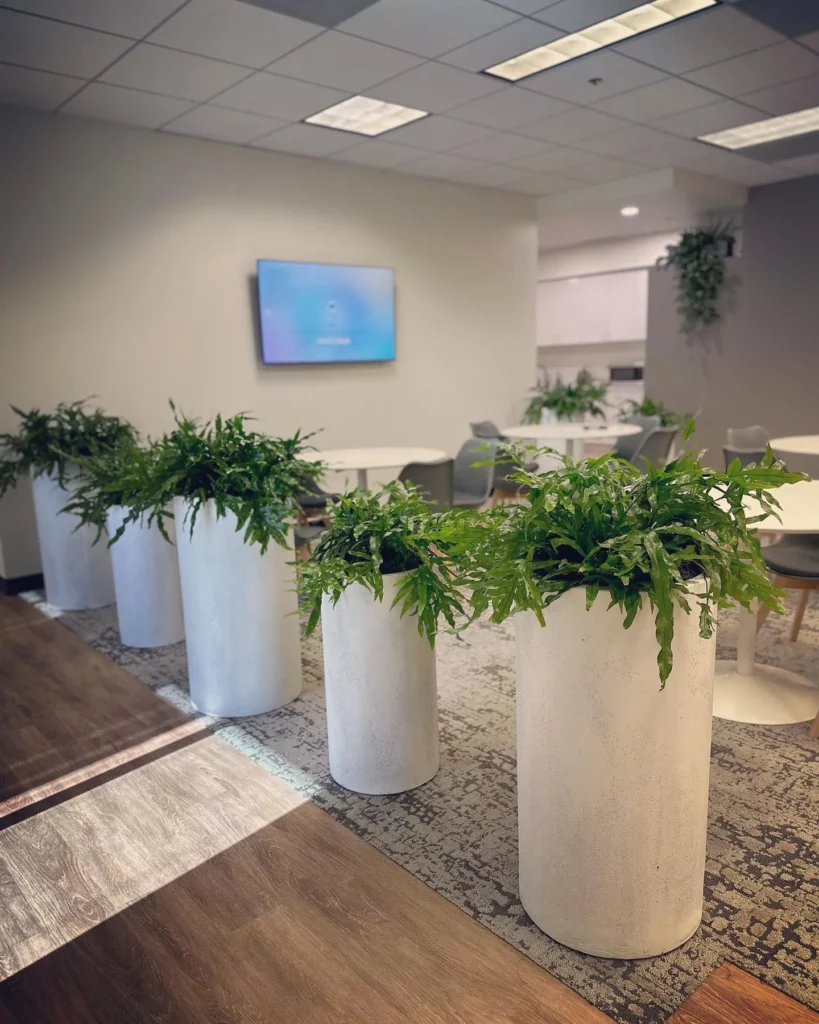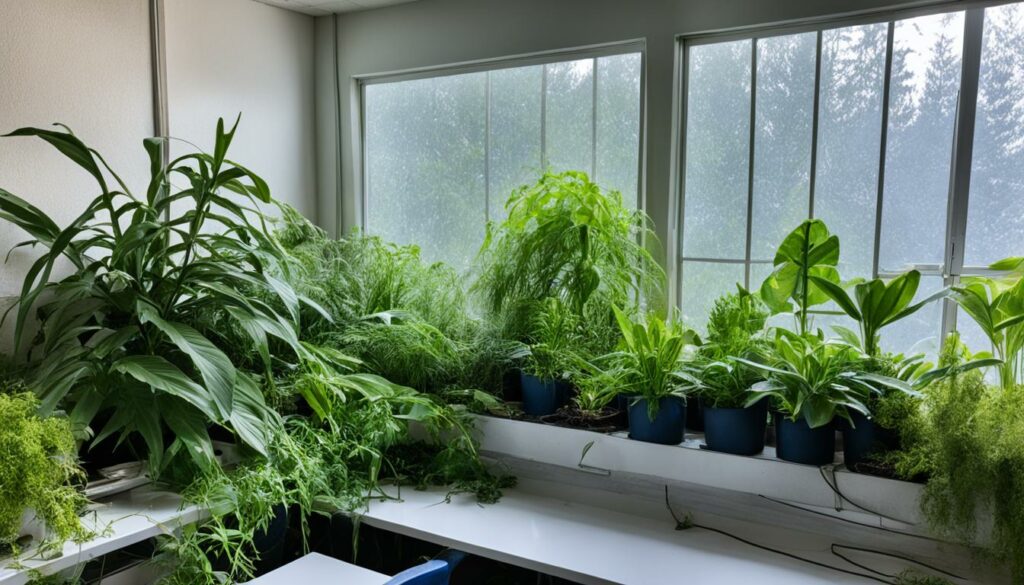Climate change is not only affecting outdoor habitats, but it is also making its presence felt indoors. The changing climate brings along a range of challenges for indoor plant owners, including increased pest infestations and diseases, fluctuations in humidity levels, and variability in natural light availability.
These factors can impact the overall health and wellbeing of your plants, leading to stunted growth, wilting, and even plant death.
No products found.
However, by recognizing the impact of climate change on indoor plants, you can take proactive steps to adapt your cultivation practices. By making informed choices and implementing sustainable strategies, you can create a healthier and thriving environment for your indoor plants to flourish.
The Rise of Houseplants and the Need for Sustainability



Houseplants have captured the hearts and homes of many, particularly among eco-friendly, health-conscious millennials. The appeal of bringing nature indoors not only adds a touch of beauty to living spaces but also offers numerous benefits for both our physical and mental well-being.
However, as the popularity of houseplants continues to soar, it is essential to prioritize sustainability in indoor plant cultivation to ensure a greener future.
No products found.
One key area of focus is reducing the carbon footprint associated with houseplants. Adopting sustainable practices such as sourcing plants locally helps minimize “plant miles” and decreases the environmental impact of long-distance transportation. By supporting nurseries and growers in your community, you contribute to a more eco-friendly and sustainable industry.
Additionally, reusing plastic pots is another significant step towards sustainability. Instead of discarding them, consider giving your plant containers a second life by cleaning and reusing them for new additions to your indoor jungle. This simple act helps reduce plastic waste and promotes a circular economy.
Minimizing the environmental impact during transportation is also crucial. When purchasing houseplants, opt for nurseries or suppliers that prioritize eco-friendly shipping methods, such as using recyclable packaging or minimizing excess materials. By making conscious choices, you contribute to a more sustainable supply chain.
The Role of Biophilic Design in Indoor Plant Cultivation

Biophilic design, with its incorporation of natural elements into indoor environments, plays a vital role in sustainable indoor plant cultivation. This design approach creates a restorative environment that mimics nature, promoting health, well-being, and productivity for both plants and humans.
No products found.
The use of natural elements, such as sunlight, water features, and natural materials, helps create a sense of connection to the outdoors. This connection has been shown to reduce stress, improve cognitive function, and enhance overall well-being.
Biophilic design also contributes to the creation of sustainable cities. By reducing the urban heat island effect through the incorporation of green roofs, vertical gardens, and green walls, indoor plant cultivation can help mitigate the effects of climate change. Additionally, the presence of indoor plants supports biodiversity and provides habitats for urban wildlife.
Indoor environments designed with biophilic principles are not only visually appealing but also have a positive impact on the planet. By adopting this approach, we can create indoor spaces that not only enhance our connection to nature but also contribute to a more sustainable future.
- Improved health and well-being
- Enhanced productivity and cognitive function
- Reduced stress and anxiety
- Mitigated climate change through the reduction of urban heat island effect
- Support for biodiversity and urban wildlife
Environmental Benefits of Indoor Plants



Indoor plants not only add a touch of natural beauty to your home but also offer numerous environmental benefits. These green companions can make a positive impact on air quality, carbon dioxide levels, energy use, mental health, and environmental education.
Improving Air Quality
Indoor plants act as natural air purifiers, effectively removing pollutants and toxins from the air. Through a process called phytoremediation, they absorb harmful chemicals and release clean oxygen, resulting in fresher and healthier indoor air.
Reducing Carbon Dioxide Levels
Indoor plants play a crucial role in reducing carbon dioxide levels in your home. Through the process of photosynthesis, plants absorb carbon dioxide and convert it into oxygen, helping to maintain a better balance of gases and reducing the carbon footprint of your living space.
Lowering Energy Use
Did you know that indoor plants can help lower your energy consumption? Strategically placing plants near windows can provide natural shade, reducing the need for additional cooling during the hot summer months. Additionally, plants can act as natural insulators, helping to keep your home warmer during colder seasons.
Enhancing Mental Health
Indoor plants have been proven to have a positive impact on mental health and well-being. Their presence can help reduce stress, anxiety, and fatigue, creating a more calming and soothing environment. Caring for plants also provides a sense of purpose and fulfillment, promoting overall emotional well-being.
Promoting Environmental Education
Having indoor plants in your home offers an excellent opportunity for environmental education, especially for children. By caring for plants and learning about their life cycle, kids can develop an understanding and appreciation for nature, fostering a love for the environment from an early age.
The Environmental Impact of Indoor Plant Cultivation

Indoor plant cultivation has its own environmental impact that should not be overlooked. Understanding and minimizing this impact is crucial for creating a more sustainable future. There are several factors to consider when it comes to the environmental footprint of indoor plants:
- Plant Miles: The transportation of indoor plants contributes to their environmental footprint. The distance a plant travels from the nursery to your home adds to its carbon emissions. Consider supporting local nurseries and suppliers to reduce the plant miles associated with your indoor plants.
- Plastic Waste: Plastic pots are commonly used for indoor plants, but they contribute to plastic waste and pollution. By reusing pots or opting for biodegradable alternatives, you can help reduce the amount of plastic waste in the environment. Choose sustainable packaging options when purchasing new plants.
- Peat-based Compost: Peat extraction for use in potting mixes results in the destruction of valuable peat bogs, which play a crucial role in carbon sequestration and biodiversity. Opt for peat-free or sustainable alternatives when choosing potting mixes to minimize the environmental impact.
- Wastage: Unfortunately, not all indoor plants thrive, and some end up being wasted. Whether it’s due to improper care, pests, or disease, minimizing plant wastage is important for reducing the environmental impact. Learn about proper plant care, seek advice from experts, and consider propagating new plants from cuttings to make the most of your indoor plant collection.
Reducing the Environmental Impact of Indoor Plant Cultivation



Indoor plant cultivation can have an environmental impact, but there are several steps you can take to minimize it. By adopting sustainable practices, you can contribute to a greener and more sustainable future.
Reduce the Use of Plastic Pots
One way to reduce the environmental impact is by reducing the use of plastic pots. Instead of buying new pots every time, consider reusing and recycling them. You can repurpose old containers or swap pots with fellow plant enthusiasts, reducing plastic waste and promoting resourcefulness.
Choose Peat-Free Potting Mix
Another step you can take is to choose peat-free potting mix. Peat extraction for horticulture contributes to the destruction of peat bogs, which are vital carbon sinks and habitats for biodiversity. Opting for peat-free alternatives helps protect these valuable ecosystems.
Opt for Sustainable Packaging
When purchasing plants, opt for sustainable packaging options. Look for nurseries and retailers that prioritize eco-friendly packaging materials, such as recycled cardboard or biodegradable plant pots. By supporting businesses that promote sustainable practices, you can make a positive impact on the environment.
The Importance of Sustainable Shopping and Propagation

When it comes to sustainable indoor plant cultivation, two practices stand out: sustainable shopping and propagation. These methods not only help reduce the environmental impact of indoor plant cultivation but also contribute to a more sustainable plant community.
One way to reduce your carbon footprint is by practicing sustainable shopping. Instead of buying plants from far-off nurseries, consider purchasing from local growers and suppliers. Buying locally reduces “plant miles,” which refers to the distance plants travel from the grower to your home.
By minimizing transportation, you can significantly reduce greenhouse gas emissions and support local businesses.
Propagation is another effective way to reduce your environmental impact. Instead of buying new plants, why not propagate your existing ones? Propagation is the process of creating new plants from cuttings or division. It not only saves money but also reduces the demand for new plants, which means less energy and resources are consumed in their production and transportation.
Additionally, plant swaps and exchanges offer a fantastic opportunity to reduce waste and contribute to a more sustainable plant community.
You can connect with fellow plant lovers and trade cuttings or small plants, giving new life to plants that might have otherwise been discarded. By participating in plant swaps, you can help reduce the demand for new plants and support a culture of sustainability and community.
Benefits of Sustainable Shopping and Propagation:
- Reduced carbon footprint through local sourcing
- Minimized environmental impact during transportation
- Savings on energy and resources by propagating plants
- Opportunity to reduce waste and support a sustainable plant community
The Role of Houseplant Owners in Creating a Sustainable Future



As houseplant owners, you have a unique opportunity to contribute to creating a sustainable future. The environmental impact of indoor plant cultivation is significant, but by adopting sustainable practices, you can make a positive difference.
Firstly, consider supporting local and eco-friendly suppliers when purchasing new plants. By buying from nurseries that prioritize sustainable practices, you can help reduce the carbon footprint associated with transportation and promote biodiversity conservation.
Secondly, take steps to minimize your own environmental impact by implementing sustainable practices in plant care. This can include using organic fertilizers, composting plant waste, and conserving water. By adopting these practices, you can not only reduce the environmental impact of your indoor garden but also create a healthier home environment for your plants.
Finally, spread awareness about the environmental impact of indoor plant cultivation. Educate others about the importance of sustainable practices and encourage them to make conscious choices when it comes to indoor plants. By doing so, you can inspire others to follow suit and contribute to a more sustainable future for all.





